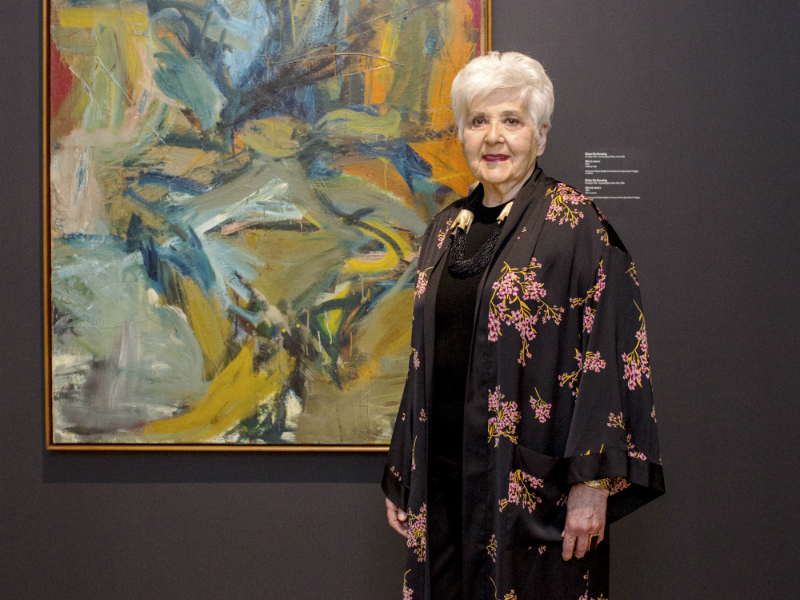Since her husband Max died in 2004, Roslyn Margles has dedicated herself to memorializing him in ways that reflect his interests, while benefitting the community.
She was looking for a permanent tribute to him, when the Montreal Museum of Fine Arts (MMFA) showed her a striking semi-abstract portrait by American artist Elaine de Kooning (1918-1989). Margles felt an immediate emotional connection to the work.
Thanks to Margles’ generous donation, the MMFA has become the first Canadian museum or public collection to acquire a work by de Kooning. The MMFA calls it a masterpiece of abstract expressionism.
Bill at St. Mark’s, a large-scale 1956 oil on canvas, now hangs permanently in the contemporary art section of the MMFA’s Michal and Renata Hornstein Pavilion for Peace.
The portrait is of the artist’s husband, Willem de Kooning (1904-1997), a Dutch-born abstract expressionist who, as was typical of the era, was better known than his wife. St. Mark’s Place in New York was the location of the East Village studio where she executed the portrait.
Born Elaine Fried in New York, de Kooning was, in her own right, a significant contributor to the avant-garde movement as artist, as well as a professor and critic, despite the prejudice women faced in the art world.
Her standing in the 20th-century art world is recognized today and the value of her oeuvre has increased, along with the scholarly attention it has received.
The MMFA is ecstatic about the acquisition, because de Kooning’s work does not come on the market frequently, said Emilie Cayer, the MMFA Foundation’s assistant director of planned giving and major gifts, and Bill at St. Mark’s is one of her best.
The MMFA relies almost entirely on private sources to buy new works. In this instance, the stars were aligned when an important American art collector offered Bill at St. Mark’s at the same time that Margles expressed her wish to fund an appropriate work in memory of her husband.
She stipulated that, whatever the selection, as many people as possible should get to see it.
In addition to the painting’s aesthetic appeal, Margles shared de Kooning’s wish to create a lasting monument to her spouse.
READ: YIDDISH THEATRE GIANT DORA WASSERMAN MEMORIALIZED IN MONTREAL
The 1.8-metre-by-1.1-metre painting is conspicuous for its bold colours and broad brushstrokes, and even bears some resemblance to Max Margles. Negotiating the terms of sale – which were not disclosed – took several weeks.
The seated figure, with his hands on his thighs and knees apart, suggests forthrightness and even challenge. The face, looking straight at the viewer, is featureless.
In the past couple of years, Bill at St. Mark’s was exhibited at the Denver Art Museum and the Mint Museum, in The Women of Abstract Expressionism exhibition.
Margles is probably best known for endowing lectures by prominent and outspoken authors at the Jewish Public Library in her husband’s name. Salman Rushdie and Ayaan Hirsi Ali are among the more recent. Her husband had been a great reader.
Max Margles was a structural engineer who worked on many big projects in downtown Montreal. The couple, who were married for more than 40 years, loved to walk through the city’s core. The MMFA, with its imposing architecture on either side of Sherbrooke Street, was, of course, always in their sights.
They had no children, so an enduring memorial to him has taken on special meaning for her.
The de Koonings had a tempestuous relationship, an open marriage and led an unconventional lifestyle. They were separated for nearly 20 years, but never divorced and eventually got back together. The union lasted 46 years until her death, Margles pointed out, joking that the longevity is where the similarity between artist and donor ends.
Although this is her first venture into art philanthropy, Margles and her husband did appreciate the visual arts, and she is especially impressed with the expansion of the MMFA’s art therapy programs in recent years, which reach segments of the public that traditionally might not have entered a museum.
Nathalie Bondil, the MMFA’s director general, said that, “From one woman to another, from one love to another, I can’t think of a more moving gesture. Thanks to our patron, Roslyn Margles, we have the honour of exhibiting this striking tableau by Elaine de Kooning, a brilliant artist too often overshadowed by her husband.”
